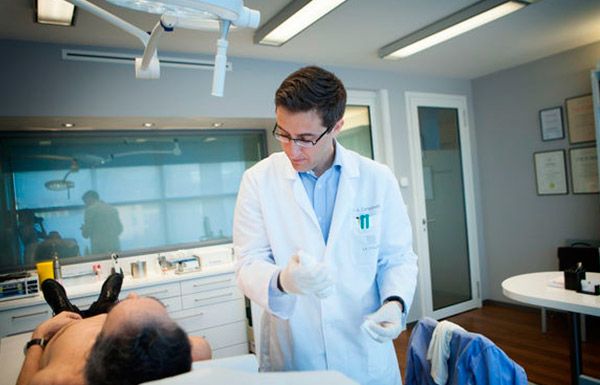Peyronie's disease
Last reviewed: 23.04.2024

All iLive content is medically reviewed or fact checked to ensure as much factual accuracy as possible.
We have strict sourcing guidelines and only link to reputable media sites, academic research institutions and, whenever possible, medically peer reviewed studies. Note that the numbers in parentheses ([1], [2], etc.) are clickable links to these studies.
If you feel that any of our content is inaccurate, out-of-date, or otherwise questionable, please select it and press Ctrl + Enter.
Peyronie's disease (fibroplastic penile induration) is idiopathic fibrosis of the gallbladder and (or) areolar connective tissue between the belly and the cavernous tissue of the penis. Peyronie's disease was first described in 1743 by Francois de la Peyronie.
 [1],
[1],
Epidemiology
The clinical symptoms of Peyronie's disease occur in 0.39-2% of cases, but this prevalence is only a statistical equivalent of the treatment for this disease. The true prevalence of Peyronie's disease is much higher - 3-4% of cases in the general male population. 64% of men who suffer from Peyronie's disease make up the age group from 40 to 59 years, with a general occurrence in a fairly large age group - from 18 to 80 years. In men under the age of 20, Peyronie's disease occurs in 0.6-1.5% of cases.
Causes of the peyronie's disease
The causes of Peyronie's illness remain not fully understood.
The most widespread theory was the occurrence of Peyronie's disease as a result of chronic traumatization of the cavernous bodies of the penis during coitus. According to the posttraumatic theory, inflammatory mediators in the zone of microtraumas of the gallbladder violate the reparative process, changing the ratio of elastic and collagen fibers in the penis. Peyronie's disease is often combined with Dupuytren's contracture and other local forms of fibromatosis, which makes it possible to characterize this disease as a local manifestation of systemic collagenosis.
There is also an autoimmune theory of the development of Peyronie's disease. According to this theory, Peyronie's disease begins with inflammation of the gallbladder shell of the cavernous bodies of the penis, accompanied by lymphocytic and plasmacytic infiltration. Infiltrate, as a rule, does not have clear boundaries. In the future, the area of fibrosis and calcification is formed in this zone. Since erection extensibility of the gall bladder in the zone of the plaque is severely limited, there is a different degree of curvature of the penis.
As a rule, the process of plaque formation and the stabilization of the disease occurs 6-18 months after its onset.
Involvement of Bucca fascia, perforating vessels and dorsal arteries of the penis in the process leads to a violation of the mechanism of occlusion of the veins and arterial insufficiency of the penis.
 [13]
[13]
Symptoms of the peyronie's disease
Symptoms of Peyronie's disease are as follows:
- erectile deformity of the penis;
- pain during erection;
- the formation of a palpable plaque or "bumps" on the penis
There are different types of clinical course of Peyronie's disease.
Symptoms of Peyronie's disease can be absent and can be manifested only by the presence of "neoplasms" of the penis, which can be detected by palpation. In the clinical course of Peyronie's disease, severe pain and deformity of the penis during erection can be present. In a number of cases, especially with the circular nature of the lesion, there is a significant shortening of the penis, and sometimes Peyronie's disease is clinically manifested only by erectile dysfunction.

In the course of the disease, Peyronie is allocated an "acute" phase and a stabilization phase, which lasts from 6 to 12 months. Complications that develop during the course of the natural course of Peyronie's disease include erectile dysfunction and shortening of the penis.
Diagnostics of the peyronie's disease
Diagnosis of the disease Peyronne, as a rule, does not present difficulties and is based on the anamnesis, complaints of the man and physical examination (palpation of the penis). Rarely Peyronie's disease masks under the carcinoma of the penis, leukemia infiltration, lymphogranuloma, lesions with late syphilis. More often, Peyronie's disease has to be differentiated from lymphangitis and thrombosis of the superficial veins of the penis.
Examination of a patient with Peyronie's disease, along with general clinical methods, suggests:
- assessment of the degree of erectile deformation (photographing, injection tests or tests with inhibitors of phosphodiesterase type 5);
- assessment of the anthropometric characteristics of the penis in a relaxed state and in a state of erection;
- research of penile hemodynamics (pharmacodopplerography, night penile tumescence).
It is advisable to conduct sexual testing.
Ultrasound of the penis is widely used in the diagnosis of Peyronie's disease. Unfortunately, the detection of a plaque with detailing of its structure is possible only in 39% of cases, due to its polymorphism and multilevel character of growth.

It is generally accepted that plaque sizes and their dynamic changes from clinical positions and for the prognosis of the disease are not critical.
Example of the formulation of the diagnosis
- Peyronie's disease, stabilization phase, erectile deformation.
- Peyronie's disease, stabilization phase, erectile deformity narrowing, erectile dysfunction.
What do need to examine?
How to examine?
Treatment of the peyronie's disease
Etiotropic treatment of Peyronie's disease is absent. As a rule, medicamental treatment and physiotherapy methods are used in the acute inflammatory phase of Peyronie's disease. The goal of conservative treatment is pain relief, limitation and reduction of inflammation zone and acceleration of resorption of infiltrates.
All methods of conservative treatment are aimed at stabilizing the pathological process. When conservative treatment using oral medications: vitamin E, tamoxifen, colchicine, carnitine, various NSAIDs.
For local administration of drugs in the plaque apply hyaluronidase (lidazu), collagenase, verapamil, interferons.
In most cases, combined treatment of Peyronie's disease is performed, using various methods of physiotherapy (electrophoresis, exposure to laser radiation or ultrasonic waves). Treatment of Peyronie's disease is carried out continuously or in fractional courses for 6 months. The data on the effectiveness of pharmacotherapy and physiotherapy in Peyronie's disease are very mixed, due to the lack of a standardized approach to the evaluation of the end results.
Operative treatment of Peyronie's disease
Curvature of the penis, which prevents or hampers the sexual act, erectile dysfunction (impotence), shortening of the penis - an indication for the surgical treatment of Peyronie's disease. Operative treatment of deviations of the penis consists in shortening the "convex" part of the cavernous bodies (Nesbit operation, plication techniques), elongation of the "concave" part of the cavernous bodies of the penis (patchwork corporaplasty), or phalloendoprosthetics.
In 1965, R. Nesbit introduced a simple method for correcting the deviation of cavernous bodies with congenital erectile deformity, and since 1979 this operational technique has become widely used in Peyronie's disease. Currently, this method in the US and many European countries is widely used both in the classical version and in modification, and many urologists regard it as a standard in the correction of curvatures in Peyronie's disease. The essence of Nesbit's operation is to cut out an ellipsoidal flap from the belly shell on the side opposite to the maximum curvature. Defect of the belly coat is sewn with non-absorbable sutures.
Modifications of the classical operation of Nesbit are distinguished by the number of areas of the belay shell that are reshaped, the options for creating intraoperative artificially erectile dysfunction, and the combination with various variants of corpoplasty, in particular with plication techniques or in combination with plaque dissection and the application of a patch of synthetic material.
An example of the modification of the operation of Nesbit is the operations of Mikulich, known in Europe as the Yachia operation. The essence of this modification is the execution of longitudinal incisions in the zone of maximum curvature of the penis with subsequent horizontal stitching of the wound.
The effectiveness of the operation of Nesbit and its modifications (according to the criterion of deformation correction) is from 75 to 96%. The disadvantages of surgery include a high risk of damage to the urethra and the neurovascular bundle with the development of erectile dysfunction (impotence) (8-23%) and loss of sensitivity of the glans penis (12%). The shortening of the penis is noted in 14-98% of cases.
An alternative to the operation of Nesbit is the plication of the gallbladder of the penis. The essence of this type of corproroplasty is invagination of the belly shell without opening the cavernous bodies in the zone of maximum deviation. In operation, a non-absorbable suture material is used. Differences in the methods of plication concern the options for creating duplicates of the belly shell, their number and marking of overlapping levels.
The effectiveness of plication Corporoplasty is very variable and ranges from 52 to 94%. The disadvantages of this type of surgery include shortening of the penis (41-90%), relapse of deformity (5-91%) and the formation of painful seals, granules that can be palpated under the skin of the penis.
Indications for plication Corporoplasty:
- Deformation angle not more than 45 °;
- absence of the syndrome of "small penis":
- absence of deformation by the type of "hourglass".
Plication Corporoplasty can be performed both with a preserved erectile function and with erectile disorders in the stage of compensation and subcompensation under the condition of the effectiveness of inhibitors of phosphodiesterase type 5. The operation of Nesbit is indicated only with a preserved erectile function at the clinical and subclinical levels.
Indications for patchwork korporoplasty ("lengthening" techniques):
- Deformation angle more than 45 °;
- syndrome of "small penis":
- change in the shape of the organ (deformity with constriction).
A prerequisite for the implementation of scrappy corproroplasty is a preserved erectile function.
Patchwork can be performed both with dissection and with excision of the plaque, followed by replacement of the defect with natural or synthetic material. The question of the optimal plastic material remains open. When scrappy corpporoplasty is used:
- autotransplants - venous wall of the large saphenous vein of the thigh or dorsal vein, skin, vaginal sheath of the testicle, vascularized flap of the preputial sac: o allotransplants - cadaveric pericardium (Tutoplasi), dura mater;
- xenotransplants - the sub-syllable layer of the small intestine of animals (SIS);
- synthetic materials gortex, silastic, dexon.
The effectiveness of patchwork (by the criterion of correction of deviation) is very variable and amounts to 75 to 96% with the use of autovenous graft. 70-75% when using a skin flap. 41% - lyophilized flap from the dura mater, 58% - vaginal sheath of the testicle. The main complication of scrappy corproroplasty is erectile dysfunction, which occurs in 12-40% of cases.
Experimental studies have confirmed the advantages of using a venous flap in comparison with cutaneous and synthetic flaps. The operation using a large saphenous vein flap was proposed by T. Lue and G. Brock in 1993 and is now widely used.
Indications for the implantation of prostheses of the penis with a one-stage correction of deformity in Peyronie's disease are the widespread lesion of the penis and erectile dysfunction (impotence) in the decompensation stage that can not be treated with phosphodiesterase-5 inhibitors. The choice of the prosthesis of the penis depends on the degree of deformation and choice of the patient. It is accepted to regard the "success" of a phalloendoprosthesis with a residual curvature of less than or equal to 15. In the case of a more pronounced residual deformation, either manual modeling by Wilson S. And Delk J. Is performed, or plaques are dissected with (without) subsequent patchwork corporoplasty.

